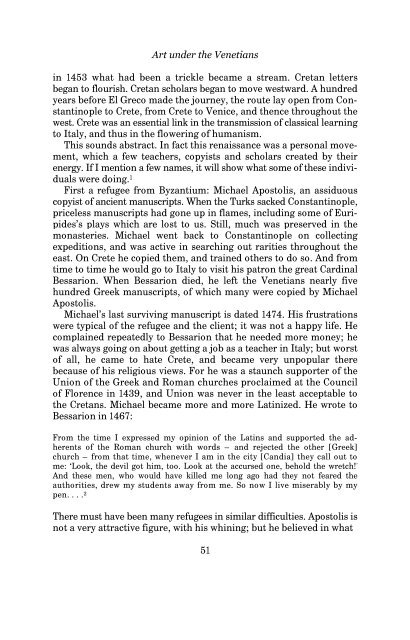free download here - Michael Llewellyn-Smith
free download here - Michael Llewellyn-Smith
free download here - Michael Llewellyn-Smith
Create successful ePaper yourself
Turn your PDF publications into a flip-book with our unique Google optimized e-Paper software.
Art under the Venetians<br />
in 1453 what had been a trickle became a stream. Cretan letters<br />
began to flourish. Cretan scholars began to move westward. A hundred<br />
years before El Greco made the journey, the route lay open from Constantinople<br />
to Crete, from Crete to Venice, and thence throughout the<br />
west. Crete was an essential link in the transmission of classical learning<br />
to Italy, and thus in the flowering of humanism.<br />
This sounds abstract. In fact this renaissance was a personal movement,<br />
which a few teachers, copyists and scholars created by their<br />
energy. If I mention a few names, it will show what some of these individuals<br />
were doing. 1<br />
First a refugee from Byzantium: <strong>Michael</strong> Apostolis, an assiduous<br />
copyist of ancient manuscripts. When the Turks sacked Constantinople,<br />
priceless manuscripts had gone up in flames, including some of Euripides’s<br />
plays which are lost to us. Still, much was preserved in the<br />
monasteries. <strong>Michael</strong> went back to Constantinople on collecting<br />
expeditions, and was active in searching out rarities throughout the<br />
east. On Crete he copied them, and trained others to do so. And from<br />
time to time he would go to Italy to visit his patron the great Cardinal<br />
Bessarion. When Bessarion died, he left the Venetians nearly five<br />
hundred Greek manuscripts, of which many were copied by <strong>Michael</strong><br />
Apostolis.<br />
<strong>Michael</strong>’s last surviving manuscript is dated 1474. His frustrations<br />
were typical of the refugee and the client; it was not a happy life. He<br />
complained repeatedly to Bessarion that he needed more money; he<br />
was always going on about getting a job as a teacher in Italy; but worst<br />
of all, he came to hate Crete, and became very unpopular t<strong>here</strong><br />
because of his religious views. For he was a staunch supporter of the<br />
Union of the Greek and Roman churches proclaimed at the Council<br />
of Florence in 1439, and Union was never in the least acceptable to<br />
the Cretans. <strong>Michael</strong> became more and more Latinized. He wrote to<br />
Bessarion in 1467:<br />
From the time I expressed my opinion of the Latins and supported the ad<strong>here</strong>nts<br />
of the Roman church with words – and rejected the other [Greek]<br />
church – from that time, whenever I am in the city [Candia] they call out to<br />
me: ‘Look, the devil got him, too. Look at the accursed one, behold the wretch! ’<br />
And these men, who would have killed me long ago had they not feared the<br />
authorities, drew my students away from me. So now I live miserably by my<br />
pen. . . . 2<br />
T<strong>here</strong> must have been many refugees in similar difficulties. Apostolis is<br />
not a very attractive figure, with his whining; but he believed in what<br />
51


